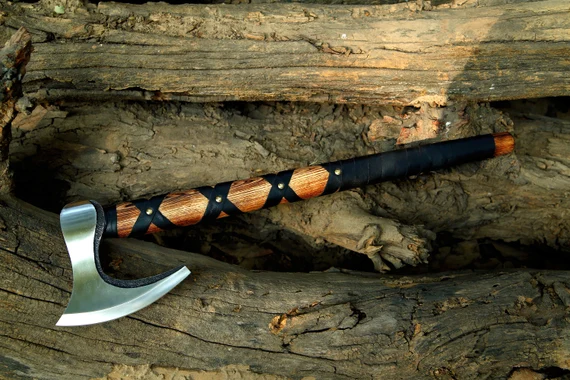The Viking Age was a time of legendary exploration, conquest, and cultural evolution. Among the many tools and weapons that defined the prowess of these seafaring warriors, none exude the raw power and mystique quite like the Viking battle axe. These formidable weapons were more than mere instruments of destruction they were symbolic extensions of the Viking spirit and a testament to their craftsmanship and strategic brilliance. Viking society was inherently martial, with warriors holding a prestigious place in the social hierarchy. The battle axe, often intricately designed and adorned, became a powerful emblem of status and courage. Wielding such a weapon required not only physical strength but also the fearlessness to engage in close combat, where a warrior’s mettle was truly tested. The axes’ design reflected the Vikings’ pragmatic approach, featuring a long wooden handle for reach and leverage, topped with a menacing metal head that could cleave through armor and bone with devastating force.

One of the most iconic variants of the Viking battle axe was the bearded axe, characterized by the elongated lower blade resembling a beard. This design innovation served a dual purpose: the extended blade offered a wider cutting edge for more efficient strikes, while the pronounced beard acted as a hook, allowing Vikings to catch and disarm adversaries. The versatility of Handgeschmiedete Äxte made it a staple on the battlefield, as it could be employed for both slashing and thrusting maneuvers. This adaptability spoke volumes about the tactical acumen of Viking warriors, who could swiftly transition between offensive strategies based on the ebb and flow of combat. Beyond their martial utility, Viking battle axes bore intricate carvings and engravings that conveyed both artistic finesse and cultural significance. The axe’s handle might be adorned with leather wrappings for a secure grip, and the metal head could feature elaborate patterns or runes mystical symbols imbued with protective qualities.
The combination of the axe’s design, the warriors’ sheer physical prowess, and their indomitable will struck terror into the hearts of their opponents. The psychological impact of the Viking battle axe cannot be understated it was an instrument of intimidation that often led to swift surrenders in the face of such an overwhelming display of force. In the annals of history, the Viking battle axe remains an indelible symbol of an era defined by exploration, conquest, and a warrior ethos that continues to captivate modern imagination. These weapons were not mere tools of war they encapsulated the Vikings’ core values of courage, honor, and the pursuit of glory. The mastery of the battle axe was an art form, and the warriors who wielded it were artisans of combat, shaping the destiny of nations with every swing. From the intricately carved handles to the formidable double-edged heads, every element of the battle axe reflected the Vikings’ dedication to excellence in both craft and combat. It is through these ancient artifacts that we continue to unravel the mystique of the Viking world and gain a deeper appreciation for the relentless spirit that forged empires amidst the clash of steel and the roar of the seas.

